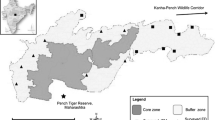Abstract
A statistical model of community participation and investment in biodiversity protection projects was developed in order to understand patterns in the effectiveness of conservation actions in forest-edge communities in Gansu, China. Extensive questionnaires were used to validate the model. The effectiveness of biodiversity programs is strongly and positively influenced by the level of public participation and investment. Higher education improves the use of resources associated with conservation, such as reduced hunting, reduced use of forest products, and the use of fuels other than wood. Nevertheless, it will be important to balance the implementation of conservation programs with the rights of communities to earn or gather a livelihood. The CBI model will benefit from further development, but proves to be a valuable tool for evaluating the design and effectiveness of biodiversity protection programs.








Similar content being viewed by others
References
Gao, T. (2006). Econometric modeling and analysis methods: Reviews, applications and examples (pp. 35–106). Beijing: Tsinghua University Press.
Jian, R, Zhu, C., & Lei, J. (1999). The research for the latifoliated red pine trees biodiversity under framework of sustainable management. Biodiversity, 7(3), 189–196.
Kou, X. (2004). Forest resources monitoring of cooperation. Shelter Forest Technology, 58(1), 54–55.
Li, Z. (2002). Advanced econometrics (pp. 63–97). Beijing: Tsinghua University Press.
Li, J., Zheng, X., & Wang, X. (2003). Northeast Forestry Bureau forest-forest biodiversity indicators System. Beijing Forestry University’s Resources and the Environment Institute, 25(1), 48–52.
Qian, Y., & Ma, K. (1994). Biodiversity research principles and methods (pp. 34–39). Beijing: China Science and Technology Press.
Tian, X. (2005). Biodiversity and conservation biology (pp. 99–103). Beijing: Chemical Industry Press.
Xue, J., & Zhang, Y. (1999). Forestry ecological environment assessment (pp. 65–83). Beijing: Economic Science Press.
Zen, Z., Luo, J., & Yan, L. (1999). Evaluation of biodiversity indicators and evaluation criteria. Hunan Forestry Science and Technology, 26(2), 26–29.
Zhao, J. (2004). Who is the main body of biodiversity protection (pp. 12–15). Yunnan University Press.
Acknowledgements
This paper has benefited immensely from the advice of Professor Wei Huilan of Lanzhou University, who provided many valuable suggestions on the logic and methods of the research. In addition, I appreciate especially the assistance of Dr. David Maddox and Dr. Marta Tellado, my good American friends who provided a lot of valuable ideas and insights and revised my article very carefully. And I also appreciate all the members of the Lanzou University community development and biodiversity protection research center, who provided important suggestions for data analysis and frame structure.
Author information
Authors and Affiliations
Corresponding author
Additional information
Readers should send their comments on this paper to: BhaskarNath@aol.com within 3 months of publication of this issue.
Rights and permissions
About this article
Cite this article
Huilan, W., Haiyun, C., Jianming, B. et al. Modeling community participation and other factors affecting biodiversity protection projects in China. Environ Dev Sustain 11, 725–734 (2009). https://doi.org/10.1007/s10668-008-9139-2
Received:
Accepted:
Published:
Issue Date:
DOI: https://doi.org/10.1007/s10668-008-9139-2




